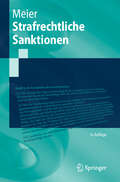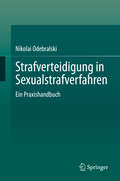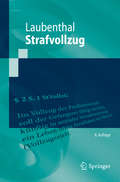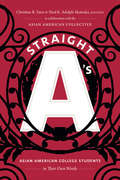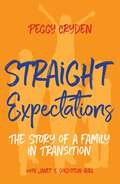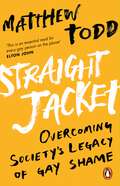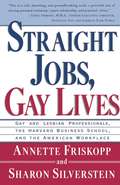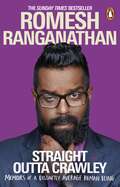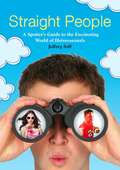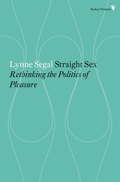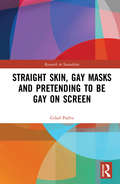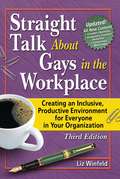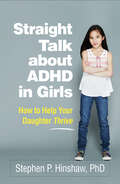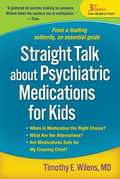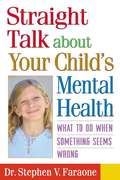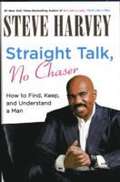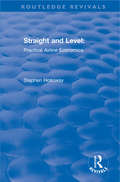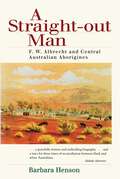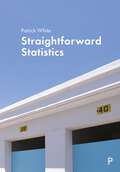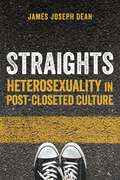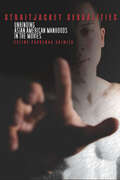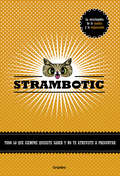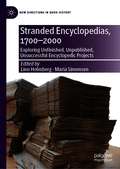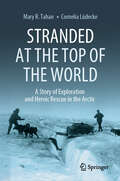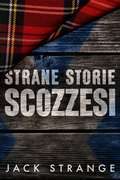- Table View
- List View
Strafrechtliche Sanktionen (Springer-Lehrbuch)
by Bernd-Dieter MeierDas Buch enthält eine Einführung in die Grundlagen des strafrechtlichen Sanktionssystems. Im Mittelpunkt stehen die rechtlichen Anwendungsvoraussetzungen der einzelnen Sanktionsarten und die Grundlagen ihrer Bemessung. Der kriminalpolitische Hintergrund sowie die kriminologischen Befunde zur Praxis der Sanktionsverhängung und -vollstreckung werden einbezogen. Der Reform des strafrechtlichen Sanktionssystems wird ein eigenständiger Abschnitt gewidmet. Das Buch wendet sich in erster Linie an Studierende der Rechtswissenschaften, die ihre Kenntnisse im Pflichtfach Strafrecht bzw. im kriminalwissenschaftlichen Schwerpunktbereich ausbauen und vertiefen wollen. Profitieren können aber auch Referendarinnen und Referendare, die im Rahmen ihrer Ausbildung im Strafrecht mit Fragen des Sanktionsrechts konfrontiert werden. Zahlreiche Einzelfälle dienen der Veranschaulichung der Materie. Übersichten und Schaubilder, Tabellen und Grafiken liefern gut verständliche Zusammenfassungen. Wiederholungs- und Vertiefungsfragen am Ende jedes Abschnitts dienen der Verständniskontrolle. Ausführliche Literaturverzeichnisse erleichtern die eigene Weiterarbeit.
Strafverteidigung in Sexualstrafverfahren: Ein Praxishandbuch
by Nikolai OdebralskiDie Verteidigung in Verfahren wegen Vergewaltigung, sexuellen Missbrauchs oder sonstiger Sexualstraftaten bedeutet für jeden Verteidiger eine besondere Verantwortung. Denn so steht für die Beschuldigten solcher Vorwürfe im Falle einer Verurteilung meist nicht nur die Freiheit, sondern auch die soziale Existenz auf dem Spiel. Angefangen bei der Beziehung zu den sonstigen Verfahrensbeteiligten über Fragen der Aussagepsychologie und Strafzumessung bis hin zum Umgang mit der Öffentlichkeit verlangt die Arbeit dem Verteidiger hier vieles ab. Dieses Buch richtet sich insbesondere an Rechtsanwälte, die sich an die Verteidigung in Sexualstrafverfahren heranwagen und hilft ihnen, diese besondere Herausforderung zu bewältigen. Zu diesem Zweck werden nicht nur die Grundbegriffe des Sexualstrafrechts erläutert und praxiserprobte Verteidigungsstrategien vorgestellt, sondern auch typische Verfahrenssituationen in den Blick genommen: neben der Verteidigung des geständigen bzw. teilgeständigen Beschuldigten bildet vor allem diejenige des vermeintlich zu Unrecht beschuldigten Mandanten einen der Schwerpunkte. In diesem Bereich ist die Konstellation von Aussage-gegen-Aussage der absolute „Klassiker des Sexualstrafverfahrens“ und wird daher hier mit besonderer Ausführlichkeit dargestellt. Die Einarbeitung aktueller Rechtsprechung, von Praxishinweisen und Statistiken zu dem speziellen Deliktsbereich runden das Werk ab und machen es zu einem wertvollen Begleiter für die Verteidigung im Sexualstrafverfahren.
Strafvollzug (Springer-Lehrbuch)
by Klaus LaubenthalSystematisch aufgebaut spannt der Autor dieses Lehrbuches den Bogen von der historischen Entwicklung über die Grundlagen des Strafvollzugs bis hin zum Vollzugssystem, dem Behandlungsprozess und den Sicherheitsaspekten. Einen Schwerpunkt bildet das Vollzugsverfahrensrecht. Unter Hinzuziehung von neuerer Rechtsprechung und Fallbeispielen werden wesentliche Problembereiche exemplarisch erläutert. Jura-Studenten und alle mit Fragen des Strafvollzugs Befasste finden wertvolle Antworten und hilfreiche Unterstützung. Autor und Verlag haben viel Wert gelegt auf den lernspezifischen Zuschnitt. In die 8. Auflage eingearbeitet wurden alle maßgebenden Gesetzesänderungen sowie die Neuregelungen zum Strafvollzug auf Länderebene. Berücksichtigt ist die jüngste Rechtsprechung der Obergerichte, insbesondere des Bundesverfassungsgerichts, zu Fragen des Freiheitsentzugs.
Straight A's: Asian American College Students in Their Own Words
by Christine R. Yano Neal K. AkatsukaThe American Dream of success for many Asian Americans includes the highest levels of education. But what does it mean to live that success? In Straight A’s Asian American students at Harvard reflect on their common experiences with discrimination, immigrant communities, their relationships to their Asian heritage, and their place in the university. They also explore the difficulties of living up to family expectations and the real-world effects of the "model minority" stereotype. While many of the issues they face are familiar to a wide swath of college students, their examinations of race, ethnicity, gender and sexuality, and culture directly speak to the Asian American experience in U.S. higher education. Unique and revealing, intimate and unreserved, Straight A’s furthers the conversation about immigrant histories, racial and ethnic stereotypes, and multiculturalism in contemporary American society.
Straight Expectations: The Story of a Family in Transition
by Janet E. Lmft Lmft Peggy CrydenEver since they were young, Peggy Cryden noticed her children's gender expression did not correspond with society's expectations of their biological gender. In this moving and honest memoir, Peggy details the experiences and challenges of raising both a gay son and a gay, transgender son and shares her family's journey of adversity and growth, which has helped inform her work as a psychotherapist. Each chapter explores a particular year in the family's life, following the children from birth to adulthood and through their numerous experiences including coming out, depression, hate crime, relationships, school and various aspects to do with transitioning (legal, physical, medical, social) as well as their appearances in the media as a family. This book is insightful, charming and thought-provoking, and through levity and humour, offers a positive approach to parenting outside of convention.
Straight Jacket
by Matthew Todd'This is an essential read for every gay person on the planet' - Elton John'A really brilliant and moving read for everybody, especially LGBTQI+ people' - Olly Alexander, star of It's A SinStraight Jacket is a revolutionary clarion call for gay men, the wider LGBT community, their friends and family. Part memoir, part ground-breaking polemic, it looks beneath the shiny facade of contemporary gay culture and asks if gay people are as happy as they could be - and if not, why not? Meticulously researched, courageous and life-affirming, Straight Jacket offers invaluable practical advice on how to overcome a range of difficult issues. It also recognizes that this is a watershed moment, a piercing wake-up-call-to-arms for the gay and wider community to acknowledge the importance of supporting all young people - and helping older people to transform their experience and finally get the lives they really want.WINNER BOYZ BEST LGBT BOOK 2017SHORTLISTED FOR THE POLARI BOOK PRIZE 2017'Insightful, inclusive, clever and engaging' - Jeremy Langmead'Utterly brilliant' - The Guardian
Straight Jobs Gay Lives: Gay and Lesbian Professionals, The Harvard Business School, and the American Workplace
by Annette Friskopp Sharon Silverstein"The workplace has become the next frontier for gay rights, " stated a Fortune magazine cover story, and this book -- based on a series of groundbreaking interviews with more than 100 gay and lesbian alumni of the Harvard Business School -- is the most complete and most in-depth study ever made of gay and lesbian managers, executives, and employees in this country. Straight Jobs, Gay Lives frankly examines issues such as coming out versus being closeted in the workplace, harassment, discrimination, health and insurance benefits, resources and support groups, and the differences between the experiences of gay men and lesbians. With hundreds of personal stories -- from men and women of all ages and races -- Straight Jobs, Gay Lives provides readers with the encouragement, information, and support that they need to navigate today's fast-changing business world.
Straight Outta Crawley: Memoirs of a Distinctly Average Human Being
by Romesh RanganathanTHE SUNDAY TIMES BESTSELLERStraight Outta Crawley is the hilarious and irreverent autobiography from comedian Romesh Ranganathan.'Very, very funny. I can't recommend it highly enough.' Jonathan Ross_________________________________At the age of 9, Romesh Ranganathan delivered his first ever stand-up set at a Pontin's holiday camp talent competition, smashing the other competitor, a young girl playing the kazoo.The gig went so well that Romesh retired his comic genius for twenty-two years, hiding behind the guise of a maths teacher, before finally revealing himself again (no, not like that) at the tender age of 31. In 2010, Ranganathan staged his epic comeback gig to an almost silent room, and has since gone on to earn his place as the most in-demand overweight vegan Sri Lankan comedian in Britain.Now, for the first time, he tells the full story of how he got here. From the delights of Sri Lankan hospitality to his struggles as a child, teacher and now parent, to his adolescent flirtation with a rap career and his attempts to make it in comedy, Straight Outta Crawley is Ranganathan's hilarious and irreverent autobiography.Have you read Romesh's latest book? As Good As It Gets: Life Lessons from a Reluctant Adult is Romesh Ranganathan's hilarious and painfully accurate dissection of what it really means to grow up.
Straight People: A Spotter's Guide to the Fascinating World of Heterosexuals
by Jeffery SelfHilarious hetero-watching guide: nesting behavior, feeding and mating habits, migration patterns, key identification features, and more
Straight Sex
by Lynne SegalIs heterosexual sex inherently damaging to women? This is the central question of Straight Sex, Lynne Segal's account of twentyfive years of feminist thinking on sexuality. Covering the thought of sixties-era sexual liberationists, alongside the ensuing passionate debates over sex and love within feminist and lesbian communities, Segal covers certain shifts toward greater sexual conservatism in the eighties. Straight Sex examines an array of issues, including sex as a subversive activity, the "liberated orgasm," sex advice literature, gender uncertainties, queer politics, anti-pornography campaigns and the rise of the moral right.From the Trade Paperback edition.
Straight Skin, Gay Masks and Pretending to be Gay on Screen: and Pretending to be Gay on Screen (Research in Sexualities)
by Gilad PadvaStraight Skin, Gay Masks and Pretending to Be Gay on Screen examines cinematic depictions of pretending-to-be-gay, assessing performances that not only reflect heteronormative and explicitly homophobic attitudes, but also offer depictions of gay selfhood with more nuanced multidirectional identifications. The case of straight protagonists pretending to be gay on screen is the ideal context in which to study unanticipated progressivity and dissidence in regard to cultural construction of human sexualities in the face of theatricalized epistemological collapse. Teasing apart the dynamics of depictions of both sexual stability and fluidity in cinematic images of men pretending to be gay offers new insights into such salient issues as sexual vulnerability and dynamics and long-term queer visibility in a politically complicated mass culture which is mostly produced in a heteronormative and even hostile cultural environment. Additionally, this book initially examines queer uses of sexuality masquerade in Alternate Gay World Cinema that allegorically features a world pretending to be gay, in which straights are harassed and persecuted, in order to expose the tragic consequences of sexual intolerance. Films and TV series examined as part of the analysis include The Gay Deceivers, Victor/Victoria, Happy Texas, William Friedkin’s Cruising and many other straight and gay screens. This is a fascinating and important study relevant to students and researchers in Film Studies, Media Studies, Gender Studies, Queer Studies, Sexuality Studies, Communication Studies and Cultural Studies.
Straight Talk About Gays in the Workplace: Creating an Inclusive, Productive Environment for Everyone in Your Organization (Gay And Lesbian Studies)
by Liz WinfeldFind out how being more LGBT inclusive can increase your organization&’s productivity-and revenues!Workplace diversity can provide creative strength and greater productivity regardless of the organization. Straight Talk About Gays in the Workplace: Creating an Inclusive, Productive Environment for Everyone in Your Organization, Third Edition presents a frank discussion about all the relevant aspects of sexual orientation and gender identity in the workplace. The author reveals how to incorporate diversity in your organization to foster greater loyalty, greater understanding, and greater productivity.Straight Talk About Gays in the Workplace: Creating an Inclusive, Productive Environment for Everyone in Your Organization, Third Edition is the latest edition of the National Library Award-winning guide that explains terms, provides strategies for implementation of policies and programs, and gives you practical tools to educate and inform employees about a workplace environment inclusive of diversity. While previous editions concentrated on the diversity of sexual orientation, this edition has been expanded and extensively updated to include the needs and issues of transgender people. Other updated information includes showing the advantages of creating an LGBT inclusive environment, discussing in-depth about the financial rewards of marketing an organization as being open to the LGBT community, and explaining the benefits of presenting these topics in public schools and higher education. Several appendices are included to provide additional resources divided into categories such as "workplace education," "transgender," "marketing," "family and the schools," "legal," and "business." The book also features a useful bibliography, an assessment tool to gauge sexual diversity in your organization, a guide for transitioning transsexuals, and another appendix that presents research and recommendations as to how school campuses can make themselves more inclusive and less discriminatory. Straight Talk About Gays in the Workplace: Creating an Inclusive, Productive Environment for Everyone in Your Organization, Third Edition discusses: updated information on domestic partner benefits educating employees about sexual orientation and gender identity the latest information on non-discrimination policies effective employee networks and alliances sensitive issues that involve transgender people opportunities and benefits of marketing to the LGBT community internal and external outreach programs crucial tax and insurance information new information focused on LGBT youth and academia inclusive of sexual orientation and gender identity and much more!Straight Talk About Gays in the Workplace: Creating an Inclusive, Productive Environment for Everyone in Your Organization, Third Edition makes essential reading for human resource professionals; executives of every type of organization; LGBT employees involved with diversity efforts; affinity groups focused on orientation and/or gender identity; educators; students; and anyone interested in studying the role of sexual orientation or gender identification diversity in the workplace.
Straight Talk about ADHD in Girls: How to Help Your Daughter Thrive
by Stephen P. HinshawParenting a daughter with attention-deficit/hyperactivity disorder (ADHD) is no easy path--especially because of the myth that the disorder is rare to nonexistent in girls. From pioneering researcher Stephen P. Hinshaw, this empowering guide provides vital information and advice to help you understand and meet your daughter's needs. Dr. Hinshaw delivers up-to-date facts on what ADHD is, why symptoms often appear differently in girls than in boys, why girls with ADHD behave the way they do, how to get an accurate diagnosis, and what treatments are most effective. There is so much pressure on girls to be "perfect"--and for those with ADHD, it feels especially hard to measure up. Learn concrete steps you can take to support your daughter's success from preschool through high school and beyond, while nurturing her confidence and self-worth.
Straight Talk about Psychiatric Medications for Kids, Third Edition
by Thomas Brown Timothy WilensDeciding whether to give your child medication for an emotional or behavioral problem is one of the toughest choices a parent can face. Will medication really help? How long will it be needed? The doctor may say it's perfectly safe--but what about the news stories about overuse and risks? From experienced child psychiatrist Dr. Timothy Wilens, this bestselling guide has already empowered many tens of thousands of parents to become active, informed managers of their children's care. Dr. Wilens explains how medications work; their impact on kids' emotions, personality, school performance, and health; the risks and benefits of widely used antidepressants; and much more. New in the Third Edition The fully updated third edition details the latest advances in treating specific disorders--with significant new information on bipolar disorder and ADHD--and offers up-to-date answers to parents' frequently asked questions.
Straight Talk about Your Child's Mental Health
by Stephen V. FaraoneParents reach for dog-eared copies of Dr. Spock when their child has a rash or the flu, but when "moodiness" lingers or worrisome behavior problems grow, they have nowhere to turn for answers or reassurance. Now, in this compassionate resource, prominent Harvard researcher Dr. Stephen V. Faraone gives parents the tools they need to look clearly at how a child is feeling, thinking, and behaving and make wise decisions about when to call for professional help. Cues and questions teach readers to become scientific observers of their child, and vital facts about common disorders help them distinguish between normal variations in speech development and Asperger syndrome, between moodiness that's just a phase and depression, between childhood fears and the symptoms of anxiety. Knowing what to ask and tell the professionals, from the pediatrician to a mental health specialist, will help parents ensure a complete and accurate diagnosis. Filled with handy sidebars, charts, and checklists, the book also teaches parents to weigh treatment options to determine what's best for their child.
Straight Talk, No Chaser: How to Find, Keep, and Understand a Man
by Steve HarveyIn the instant number one New York Times bestseller Act Like a Lady, Think Like a Man, Steve Harvey gave millions of women around the globe insight into what men really think about love, intimacy, and commitment. In his new book he zeros in on what motivates men and provides tips on how women can use that knowledge to get more of what they need out of their relationships, whether it's more help around the house, more of the right kind of attention in the bedroom, more money in the joint bank account, or more truth when it comes to the hard questions, such as: Are you committed to building a future together? Does my success intimidate you? Have you cheated on me? In Straight Talk, No Chaser: How to Find, Keep, and Understand a Man, Steve Harvey shares information on: How to Get the Truth Out of Your Man * Tired of answers that are deceptive? Harvey lays out a three-tier, CIA-style of questioning that will leave your man no choice but to cut to the chase and deliver the truth. Dating Tips, Decade by Decade * Whether you're in your twenties and just starting to date seriously, in your thirties and feeling the tick of the biological clock, or in your forties and beyond, Steve provides insight into what a man, in each decade of his life, is looking for in a mate. How to Minimize Nagging and Maximize Harmony at Home * He said he'd cut the lawn on Saturday, and you may have been within reason to think that that meant Saturday before ten in the evening, but exploding at him is only going to ruin the mood for everyone, which means no romance. Steve shows you how to talk to your man in a way that moves him to action and keeps the peace. And there's much more, including Steve's candid answers to questions you've always wanted to ask men. Drawing on a lifetime of experience and the feedback women have shared with him in reaction to Act Like a Lady, Think Like a Man, Harvey offers wisdom on a wealth of topics relevant to both sexes today. He also gets more personal, sharing anecdotes from his own family history. Always direct, often funny, and incredibly perceptive, media personality, comedian, philanthropist, and (finally) happily married husband, Steve Harvey proves once again that he is the king of relationships.
Straight and Level: Practical Airline Economics
by Stephen HollowayThis title was first published in 2003.Airline operating profits are well known to be volatile, and the global industry aggregate figures conceal wide differences in performance between carriers. The fundamental reasons for the poor performance of the industry as a whole were in the early 1990's that output ran too far ahead of demand, and the yield earned on output sold was insufficient to cover costs. In strategic context, this second edition uses a simple yet powerful model to explore linkages between the fundamentals of airline economics and the volatility of industry results at the operating level. Its five parts look in turn at strategic context, supply side, demand side, network management and a general conclusion.
Straight-Out Man: F.W. Albrecht and Central Australian Aborigines
by Barbara HensonCentral Australia and its oldest mission, Hermannsburg, have long been a potent arena for the encounter between Australia's indigenous people and the European newcomers. The life of Hermannsburg's longest serving superintendent, F. W. Albrecht, vividly details much of that encounter, beginning in the 1920s when Aborigines were thought to be a dying race, with governments and public largely indifferent to their fate. Described by some as Australia's greatest missionary, Albrecht battled to gain secure reserves on traditional lands, and to foster Aboriginal education, employment and leadership. Prominent figures crossed his path: Flynn of the Inland,T. G. H. Strehlow—and Albert Namatjira, in whose life and painting Albrecht played a key role. Aboriginal recollections punctuate the story, providing a rare glimpse into Aboriginal thoughts and feelings for Albrecht himself and the events surrounding them. And at the centre is a man of great personal commitment, struggling with the painful unlearning of his own cultural certainties. This is subtle and compelling storytelling.
Straightforward Statistics
by Patrick WhiteAre you struggling with introductory statistics? Are you trying to get ahead in your course, but feel like you're going around in circles? This short and down-to-earth textbook will give you the knowledge and confidence you need to get acquainted with the fundamentals of statistical concepts and techniques. Assuming no prior knowledge, and avoiding jargon and dense equations, it will ease your anxiety and demonstrate the value of good descriptive analysis. With a focus on practical use and outcomes, the book: • provides an accessible grounding in the key elements of descriptive statistical analysis; • has a clear focus on techniques to describe patterns and relationships in your data; • provides helpful summaries and exercises, and a glossary of terms to reinforce understanding. With over 20 years’ experience in teaching statistics at all levels and to students from many different subject areas, Patrick White has written an invaluable guide to key concepts and basic statistical techniques. Regardless of your background, this is the book that will help you interpret and use numbers to make the breakthrough that you need to achieve success in your university course.
Straights: Heterosexuality in Post-Closeted Culture
by James Joseph DeanExplores how straight Americans make sense of their sexual and gendered selvesSince the Stonewall Riots in 1969, the politics of sexual identity in America have drastically transformed. It’s almost old news that recent generations of Americans have grown up in a culture more accepting of out lesbians and gay men, seen the proliferation of LGBTQ media representation, and witnessed the attainment of a range of legal rights for same-sex couples. But the changes wrought by a so-called “post-closeted culture” have not just affected the queer community—heterosexuals are also in the midst of a sea change in how their sexuality plays out in everyday life. In Straights, James Joseph Dean argues that heterosexuals can neither assume the invisibility of gays and lesbians, nor count on the assumption that their ownheterosexuality will go unchallenged. The presumption that we are all heterosexual, or that there is such a thing as ‘compulsory heterosexuality,’ he claims, has vanished.Based on 60 in-depth interviews with a diverse group of straight men and women, Straights explores how straight Americans make sense of their sexual and gendered selves in this new landscape, particularly with an understanding of how racedoes and does not play a role in these conceptions. Dean provides a historical understanding of heterosexuality and how it was first established, then moves on to examine the changing nature of masculinity and femininity and, most importantly, the emergence of a new kind of heterosexuality—notably, for men, the metrosexual, and for women, the emergence of a more fluid sexuality. The book also documents the way heterosexuals interact and form relationships with their LGBTQ family members, friends, acquaintances, and coworkers. Although homophobia persists among straight individuals, Dean shows that being gay-friendly or against homophobic expressions is also increasingly common among straight Americans. A fascinating study, Straights provides an in-depth look at the changing nature of sexual expression in America.
Straitjacket Sexualities: Unbinding Asian American Manhoods in the Movies
by Shimizu Celine ParreñasDepictions of Asian American men as effeminate or asexual pervade popular movies. Hollywood has made clear that Asian American men lack the qualities inherent to the heroic heterosexual male. This restricting, circumscribed vision of masculinity-a straitjacketing, according to author Celine Parreñas Shimizu-aggravates Asian American male sexual problems both on and off screen. Straitjacket Sexualities: Unbinding Asian American Manhoods in the Movieslooks to cinematic history to reveal the dynamic ways Asian American men, from Bruce Lee to Long Duk Dong, create and claim a variety of masculinities. Representations of love, romance, desire, and lovemaking show how Asian American men fashion manhoods that negotiate the dynamics of self and other, expanding our ideas of sexuality. The unique ways in which Asian American men express intimacy is powerfully represented onscreen, offering distinct portraits of individuals struggling with group identities. Rejecting "macho" men, these movies stake Asian American manhood on the notion of caring for, rather than dominating, others. Straitjacket Sexualitiesidentifies a number of moments in the movies wherein masculinity is figured anew. By looking at intimate relations on screen, power as sexual prowess and brute masculinity is redefined, giving primacy to the diverse ways Asian American men experience complex, ambiguous, and ambivalent genders and sexualities.
Strambotic
by StramboticUno de los blogs de actualidad más leídos por fin en libro. Una recopilación de noticias sobre lo disparatado e insólito. ¿De dónde sacaba Mr. T los 8 kilos de collares de oro que lucía en su pecho? ¿Cómo dicen los franceses «hacer un francés»? ¿Quién compuso la tonadilla de Movierecord? ¿Por qué los jueves siempre hay paella en el menú del día de los restaurantes? Este libro te ofrece la respuesta a estas y otras muchas preguntas que probablemente nunca te habías hecho, pero con las que te convertirás en el rey de las celebraciones familiares y las cenas de empresa. Iñaki Berazaluce y Daniel Civantos, creadores de Strambotic, probablemente el blog más cachondo de todos los tiempos, ahora también en papel. Sobre Strambotic, la enciclopedia de lo insólito y lo disparatado, la crítica ha dicho...«El libro que hace obsoleto a todos los demás libros.»Harvarx Book Review «He perdido varios meses de mi vida leyendo Strambotic en internet. Ahora puedo seguir haciéndolo también en el baño.»El Avanzado de Segovia «Es horrible y es divertido; e incluso horriblemente divertido.»The Morning Expressen «La mayor retahíla de sandeces que he leído jamás. Me ponga dos.»Revista Presto
Stranded Encyclopedias, 1700–2000: Exploring Unfinished, Unpublished, Unsuccessful Encyclopedic Projects (New Directions in Book History)
by Linn Holmberg Maria SimonsenIn Stranded Encyclopedias, 1700–2000: Exploring Unfinished, Unpublished, Unsuccessful Encyclopedic Projects, fourteen scholars turn to the archives to challenge the way the history of modern encyclopedism has long been told. Rather than emphasizing successful publications and famous compilers, they explore encyclopedic enterprises that somehow failed. With a combined attention to script, print, and digital cultures, the volume highlights the many challenges facing those who have pursued complete knowledge in the past three hundred years. By introducing the concepts of stranded and strandedness, it also provides an analytical framework for approaching aspects often overlooked in histories of encyclopedias, books, and learning: the unpublished, the unfinished, the incomplete, the unsuccessfully disseminated, and the no-longer-updated. By examining these aspects in a new and original way, this book will be of value to anyone interested in the history of encyclopedism and lexicography, the history of knowledge, language, and ideas, and the history of books, writing, translating, and publishing. Chapters 1 and 4 are available open access under a Creative Commons Attribution 4.0 International License via link.springer.com.
Stranded at the Top of the World: A Story of Exploration and Heroic Rescue in the Arctic
by Cornelia Lüdecke Mary R. TahanThis book provides a well-researched, well-structured, interesting, and informative narrative depicting the little-known yet successful efforts of the Captain Arve Staxrud Norwegian Arctic Rescue Expedition of 1913 that searched for and saved members of the Lieutenant Herbert Schröder-Stranz German Arctic Expedition of 1912 in Spitsbergen (Svalbard). The book portrays the cooperative and strategic endeavors of the humans and animals involved in the Staxrud expedition who worked together to save human lives on the icy fjords and glaciers of the far north during an unseasonable time of year for exploratory expeditions. It examines and analyzes the unpreparedness and lack of training that resulted in the failure of the Schröder-Stranz expedition. It compares and contrasts concurrent rescue expeditions that failed, including the Kurt Wegener expedition and the Theodor Lerner expedition. It describes the crucial role of animals in both the Norwegian and German expeditions, as well as German interest and Norwegian activity in Spitsbergen leading up to the expeditions. And it reconstructs the interaction and organization of principal officers, overwintering experts, Norwegians, Sámi, draft reindeer teams, and experienced sledge dogs who made the Staxrud rescue mission a success and who created and enabled improved search and rescue capabilities for Spitsbergen and for the future of the Arctic archipelago.
Strane Storie Scozzesi
by Jack StrangeStrane Storie Scozzesi presenta un aspetto particolare dei misteri della Scozia. Conoscerete il fantasma che apparve al matrimonio di re Alessandro II e mostri come lo Shellycoat e il Cavallo Marino, ritenuti gli abitanti dei laghi della Scozia. Leggerete poi di Loch Ness e gli strani eventi che sono successi in questo misterioso specchio d’acqua. Viaggerete verso le isole Flannan dove i guardiani del faro spariscono e incontrerete le strane creature che una volta si pensava infestassero le colline e le valli della Scozia, tra cu il terrificante Brollachan e la sua carneficina. Conoscerete alcune storie di sirene e tritoni e delle orribili grotte della Scozia, traboccanti di sacrifici umani come quella detta Dello Scultore di Moray. Ci saranno anche le leggende sulla Cappella di Roslin e del suo castello con un possibile collegamento con i Templari. E poi eserciti fantasma, con soldati che si rifiutarono di scomparire persino secoli dopo che le loro guerre si erano concluse ed erano svanite nella storia. Benvenuti nelle Strane Storie Scozzesi.
